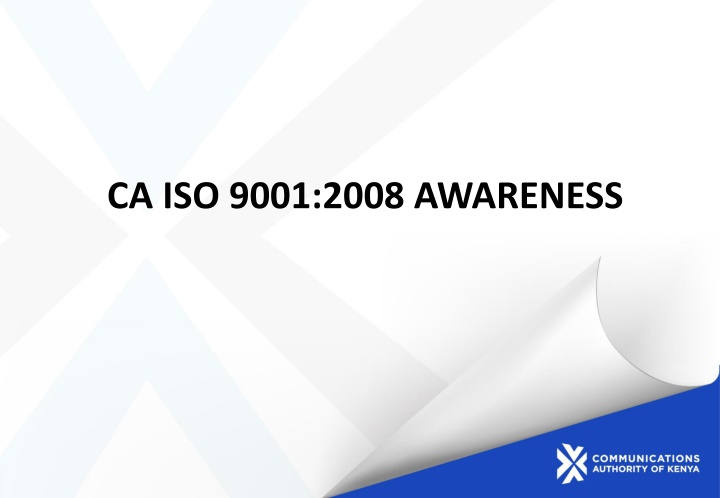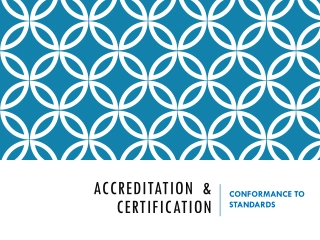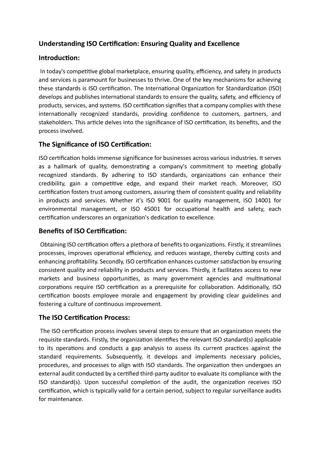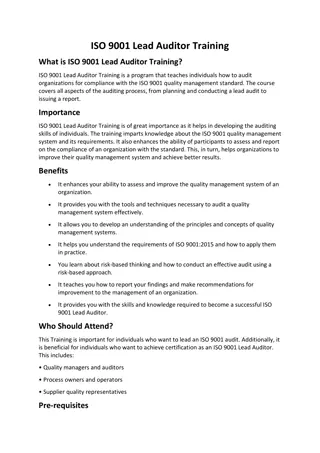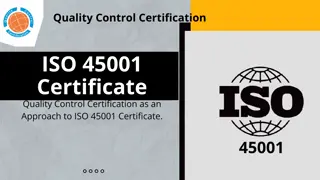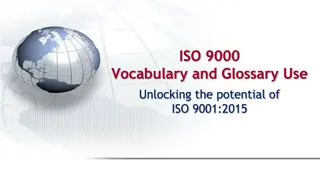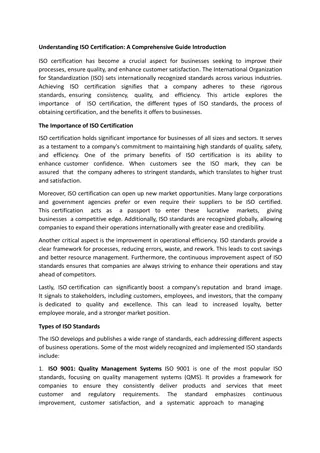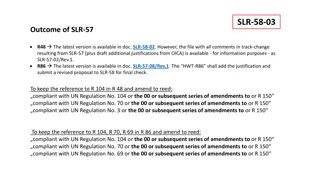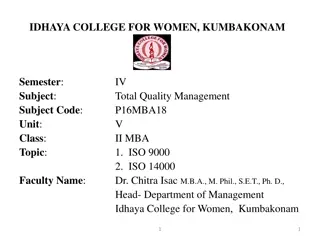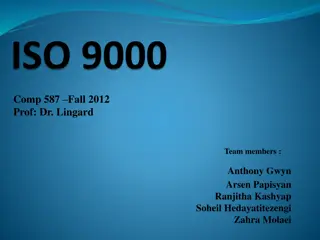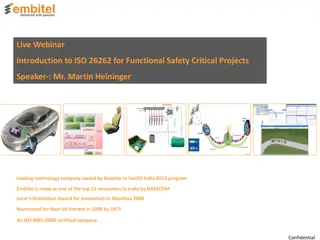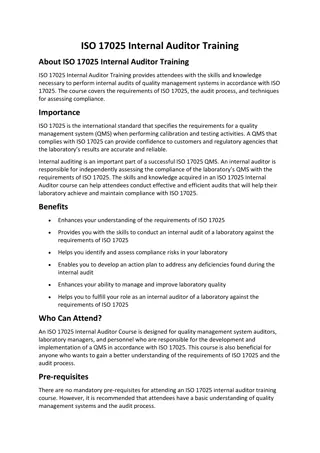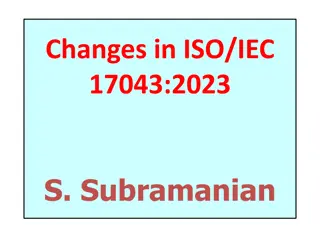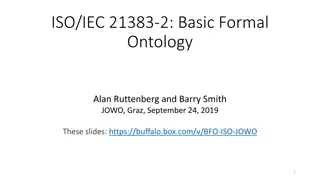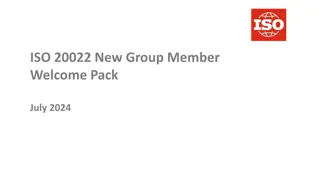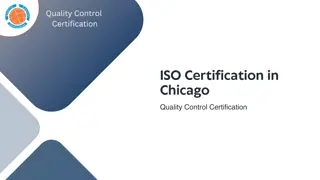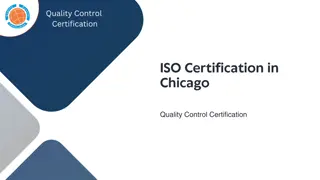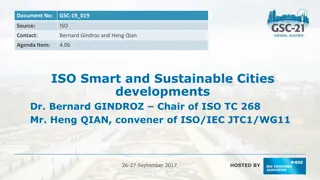Understanding ISO Standards and Their Importance
Explore the history, purpose, and working process of ISO, an international agency developing standards to enhance trade and product/service quality. Learn about ISO's structure, benefits, and how standards are identified. Discover why ISO is crucial for efficient, safe, and fair global trade practices.
Download Presentation

Please find below an Image/Link to download the presentation.
The content on the website is provided AS IS for your information and personal use only. It may not be sold, licensed, or shared on other websites without obtaining consent from the author.If you encounter any issues during the download, it is possible that the publisher has removed the file from their server.
You are allowed to download the files provided on this website for personal or commercial use, subject to the condition that they are used lawfully. All files are the property of their respective owners.
The content on the website is provided AS IS for your information and personal use only. It may not be sold, licensed, or shared on other websites without obtaining consent from the author.
E N D
Presentation Transcript
Session Outline Definition of ISO How ISO started Structure and features of ISO 9000 QMS standards Benefits of implementation of ISO 9000 QMS
Who is ISO? ISO is an international agency that develops international standards to foster increased trade of products and services. ISO consists of 162 member countries. A country becomes a member of ISO through its national standards body e.g. Kenya is a member through Kenya Bureau of standards ISO officially began operations on 23rd February1947
History of ISO ISO S NAME "International Organization for Standardization has different acronyms in different languages, its founders therefore decided to give it ISO a short, all-purpose name. They chose "ISO", derived from the Greek isos, meaning "equal". Whatever the country, whatever the language, the short form of the organization's name is always ISO.
History of ISO HOW ISO WORKS The work of preparing international standards is normally carried out by ISO through ISO technical committees. Each member body interested in a subject for which a technical committee has been established has the right to be represented in that committee. International organizations, both governmental and non governmental, in liaison with ISO, also take part in the work.
Purpose of Standards To make the development, manufacturing and supply of products and services more efficient, safer and cleaner. To facilitate trade between countries and make it fairer. To provide governments with a technical base for health, safety and environmental legislation, and conformity assessment,
Purpose of Standards To share good management practice, To safeguard consumers and users in general, of poor products and services, To make life simpler by providing solutions to common problems.
Standards Identification Standards are identified through indexing e.g. i. KS denotes Kenya Standard ii. BS denotes British Standard iii. ISO denotes International Standard These are followed by a number e.g. i. ISO 9000 the number 9000 is allocated by the international standardization agency ii. BS 5750 the number 5750 is allocated by the British standards institute iii. KS 1515 the number 1515 is allocated by the Kenya Bureau of standards The last number is the year the standard was published e.g. ISO 9001:2008
History and Evolution of ISO 9000 During World War II, there were quality problems in many European industries such as those of ammunitions, where bombs were exploding in factories during assembly. The solution adopted to address these quality problems required factories to document their manufacturing procedures and to prove by record-keeping that the procedures were being followed according to the Allied Quality Assurance Programme (AQAP). After the war, the British government adopted this solution as BS 5750 in 1973.
History and Evolution of ISO 9000 The base document to ISO 9000 was BS 5750, and it was known as a management standard because it specified not what to manufacture, but how the manufacturing process was to be managed. In 1987, the International Organization for Standardization (ISO) adopted BS 5750 as an international standard. The international standard was named ISO 9000.
The ISO 9000 Family Four Primary standards ISO 9000:2005, QMS Fundamentals and Vocabulary ISO 9001:2008, QMS Requirements ISO 9004:2009, Managing for the sustained success of an organization - A quality management approach ISO 19011:2002, Guidelines on Quality and/or Environmental management systems auditing
Benefits of Implementation Operational efficiency Enhanced customer satisfaction Improved financial return Satisfaction of other stakeholders Sustainability Continual improvement International recognition
Clause 1: Scope Talks about the standard and how it applies to organizations ISO 9001:2008 is intended to be generic and applicable to all organizations, regardless of type, size and product category. It is recognized, however, that not all the requirements of this standard will necessarily be relevant to all organizations. Under certain circumstances, an organization may consider the exclusion of the application of some requirements of ISO 9001:2008 from its QMS.
Clause 2: Normative Reference References another document that should be used along with the standard, ISO 9000:2005, Quality Management Systems Fundamentals and Vocabulary
Clause 3: Terms and Definitions Refers to ISO 9000:2005 for terms and definitions used in the standard.
Clause 4: General Requirements This Clause gives the requirements for the foundation or establishment of the Quality Management System (QMS): - QMS General requirements Documentation requirements: - i. Quality Manual ii. Control of Documents iii. Control of Records
Clause 5: Management Responsibility Gives requirements for Management and their role in the Quality Management System: - Management Commitment Customer focus Quality Policy Planning Quality Objectives QMS planning Responsibility, authority and communication Management Representative Management Review
Clause 6: Resource Management Gives requirements for resources including personnel, training, the facility and work environment: - Provision of Resource Human Resources Infrastructure Work Environment
Clause 7: Product Realization Gives requirements for the production of the product or service, including activities like planning, customer related processes, design, purchasing and process control: - Planning of Product Realization Customer-related processes Design and Development Purchasing Production and service provision Control of monitoring and measuring equipment
Clause 8: Measurement, Analysis and Improvement Provides requirements on monitoring and improving products and established processes: - General requirements of measurement, analysis and improvement Monitoring and measurement Control of nonconforming product Analysis of data Improvement
CAs Certification The Authority was certified in 2009 and has maintained the certification through; Internal Audits Surveillance Audits Management Review Meeting
CAs QMS The CA s Quality Management System comprise of; Quality Policy Quality Manual Mandatory Documents 12 Departmental/Division Procedures
